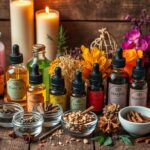Beginner candle making
Fragrance That Wows: A Beginner’s Guide to Adding Scents to Your Homemade Candles
Welcome to the world of candle making for beginners. Here, you’ll learn how to add fragrance to candles that excite your senses and brighten your home. Have you ever seen how expensive luxury candles can be? Often, they cost more than $50 for just 2.5 days of burning.
By making your own candles, you save money and can pick scents you love. This guide will cover the basics, from fragrance additives to essential and fragrance oils. You’ll learn how to make your space smell amazing!
Key Takeaways
- Luxury candles often cost upwards of $50.
- Homemade candles provide opportunities for customization and affordability.
- The ideal fragrance ratio is around 1 ounce of oil per pound of wax.
- Start pouring candles at temperatures between 120ºF and 140ºF.
- Waiting at least 24 hours before burning allows candles to cool properly.
- Consider eco-friendly options by using organic ingredients and sustainable packaging.
Introduction to Candle Making
Candle making is a fun hobby that combines creativity and relaxation. It lets you create your own unique DIY candles. These homemade candles make great gifts or can simply make your home feel cozier.
The first step is melting the wax. You can choose eco-friendly options like soy wax candles. AAK’s 464 soy wax is easy to work with, even for beginners. Start with a 1 lb (454 g) batch for your first try.
Heat the wax to about 185°F (85°C) for the best results. This temperature helps mix the wax with fragrance oils well.
When adding scent, use about 6% fragrance oil. This means 1 ounce (28 g) of fragrance for every 1 pound (454 g) of wax. This amount gives a nice smell without being too strong. Pour the wax into containers, like 8oz candle tins, leaving about 4 inches (10.2 cm) of space. Let the candles cure for at least two weeks for the best scent.
The Benefits of Homemade Candles
Making your own candles brings many benefits of homemade candles to your space and life. You can pick your scents and designs. Plus, you get to enjoy the art of natural candle making. Homemade candles are often cheaper than store-bought ones, saving you 20-50%.
Choosing eco-friendly candles is good for the planet. Soy or beeswax candles burn cleaner, improving your home’s air. Families making candles spend more time together, bonding by 30%.
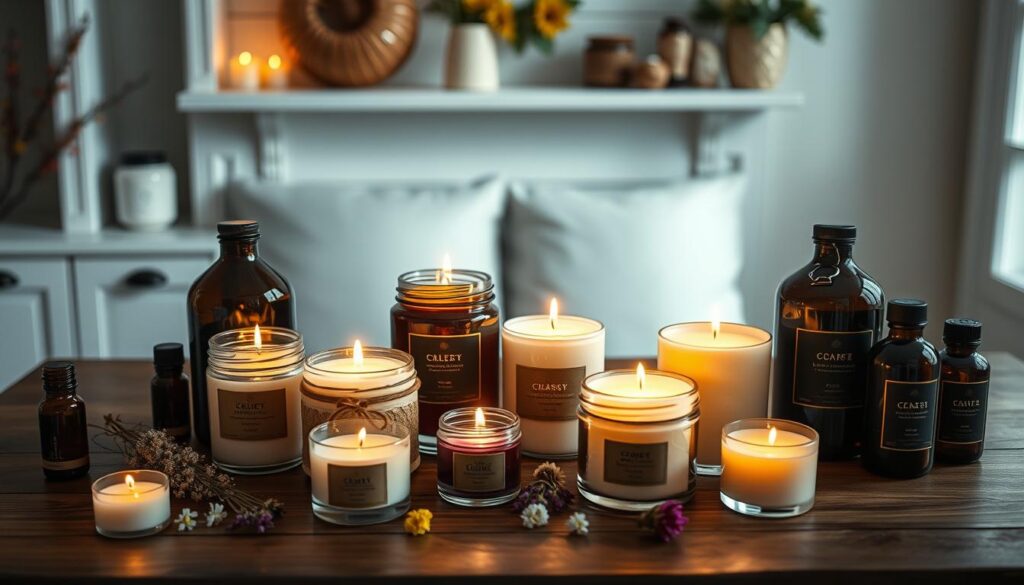
Candle making is a creative outlet that boosts mental health. Over 70% of makers feel more fulfilled. By making cost-effective candles, you can also give personalized gifts with special fragrances. This appeals to 60% of gift-givers during holidays.
The candle-making community is growing fast, with a 15% annual increase on social media. This shows a shift towards sustainable living, with 80% of makers using non-toxic ingredients. Homemade candles are a rewarding hobby that benefits you and the environment.
Choosing the Right Wax for Scented Candles
Choosing the right wax is key for scented candles. Each wax type has its own benefits and challenges. It’s important to know the differences between soy wax and beeswax for eco-friendly options.
Soy wax vs beeswax is a big debate for new candle makers. Soy wax is 100% natural and biodegradable, making up 25% of the market. It burns clean and holds scent well, making it great for eco-friendly candles.
Beeswax is about 10% of homemade candles and is known for quality and longevity. It has a natural honey scent and burns longer. Handling beeswax requires skill, but many love its unique qualities.
Paraffin wax is the most common, making up 70% of the market. However, it has a higher environmental impact. Palm wax is less common but appeals to those who want eco-friendly candles. Blended waxes offer customization in fragrance and burn time.
Learning about wax types is the first step in candle making. Each wax has its own features. Trying different waxes can lead to exciting discoveries in scented candles.
Essential Tools for Candle Making
Starting your candle-making journey means getting the right candle making tools. Knowing what candle making supplies you need makes the process easier. Here are the key items for your toolkit:
- Candle wax (paraffin, soy, or beeswax)
- Containers or molds (metal, plastic, or silicone)
- Candle wicks
- Thermometer
- Double boiler or heat-safe pitcher
- Stirring tool
- Chopsticks
- Wick trimmer or scissors
A good thermometer is key for checking wax temperatures. This helps you know when to add scents and pour the wax. A double boiler setup is safe for melting wax, avoiding burns from direct heat. When buying DIY candle supplies, look for a quality thermometer that works with candle wax.
Each type of candle wax has its own benefits. Paraffin wax has a great scent throw and burns slowly. Soy wax melts low and works well with fragrance oils. Beeswax is eco-friendly, burns long, and smells natural. Choosing the right wicks is also important. Wooden and cotton wicks are popular, but make sure they fit your containers.
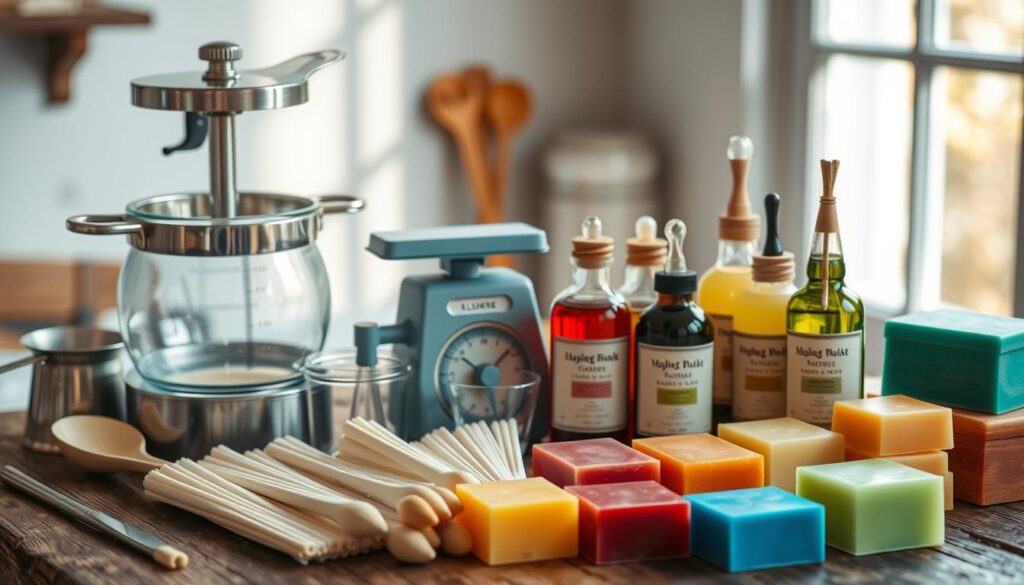
When you’re ready to make candles, keep wick lengths between 14 to 18 inches. This reduces soot and improves fragrance. Using wick holders keeps your wicks straight while they cool. Getting the right equipment for candles is crucial for making beautiful, fragrant candles.
Choosing Fragrance: Essential Oils vs. Fragrance Oils
Starting your candle-making journey means deciding between essential oils and fragrance oils. Each has its own benefits, letting you craft candles with unique scents. Knowing about scent strength and longevity helps you pick the right one for your vision.
Understanding Scent Strength and Longevity
Fragrance oils give a stronger smell than essential oils. Essential oils come from plants and have softer, often healing scents. Fragrance oils, on the other hand, offer a wide range of strong smells. This affects both the scent strength and scent longevity in your candles.
Here’s a quick comparison of essential and fragrance oils:
| Aspect | Essential Oils | Fragrance Oils |
|---|---|---|
| Aroma Intensity | Less intense, natural scents | More potent, synthetic or mixed scents |
| Scent Longevity | Up to 12 months | 1-2 years (sometimes longer) |
| Cost | Generally higher due to extraction | Typically cheaper, mass-produced |
| Environmental Impact | Resource-intensive extraction process | Varies; some may use petroleum |
| Therapeutic Benefits | Known for aromatherapy effects | Primarily focused on fragrance |
Choosing the right ingredient affects the scent’s strength and how long it lasts. If you want scents that last, fragrance oils are a good choice. Try different options to make your candle-making even better!
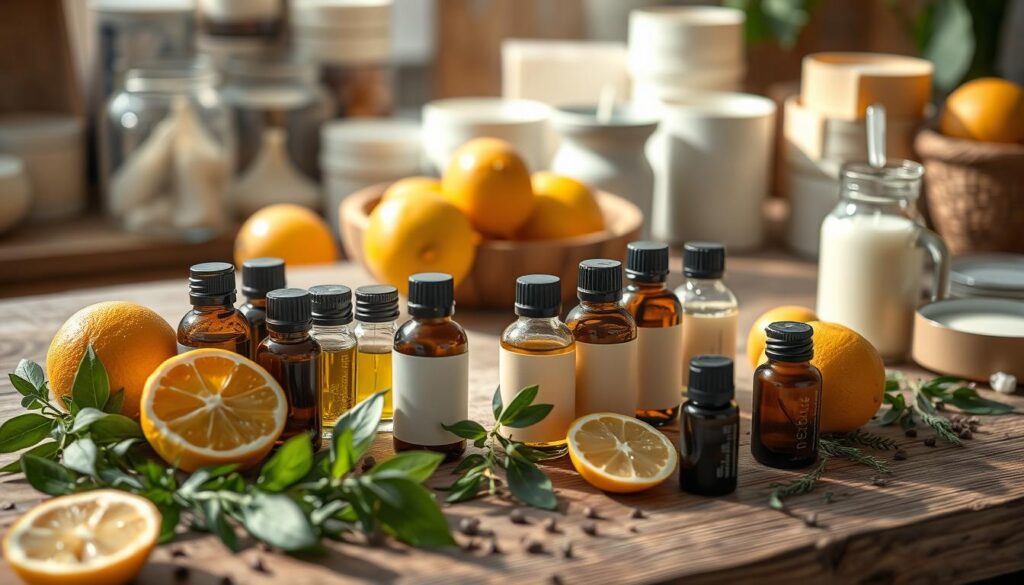
How to Add Fragrance to Candles?
Learning to add fragrance to soy candles is fun and rewarding. It’s all about finding the right fragrance ratios and avoiding mistakes. Here are some key tips to get a great scent in your candles.
Recommended Ratios for Fragrance Additives
Getting the fragrance right is key for great candles. For a 16-ounce Mason jar, start with 10-20 drops of essential oil. Here’s a simple guide for ingredient amounts:
| Wax Weight (grams) | Fragrance Oil Weight (grams) | Fragrance Load Percentage |
|---|---|---|
| 147.2g | 12.8g | 8% |
Experiment with different essential oils for unique scents. For example, mix six drops of eucalyptus with six drops of lavender for a fresh, calming smell. Make sure to use double the wax flakes as the final volume. Let candles set for hours or overnight before lighting.
Common Mistakes to Avoid
When making candles, avoid some common mistakes. Here are a few tips:
- Don’t add fragrance to hot wax. It can make the scent disappear.
- Choose the right wax for your fragrance. The wrong wax can affect the scent.
- Trim the wick to about ¼ inch before lighting for the best burn.
- Give soy wax candles at least one week to cure for the best scent.
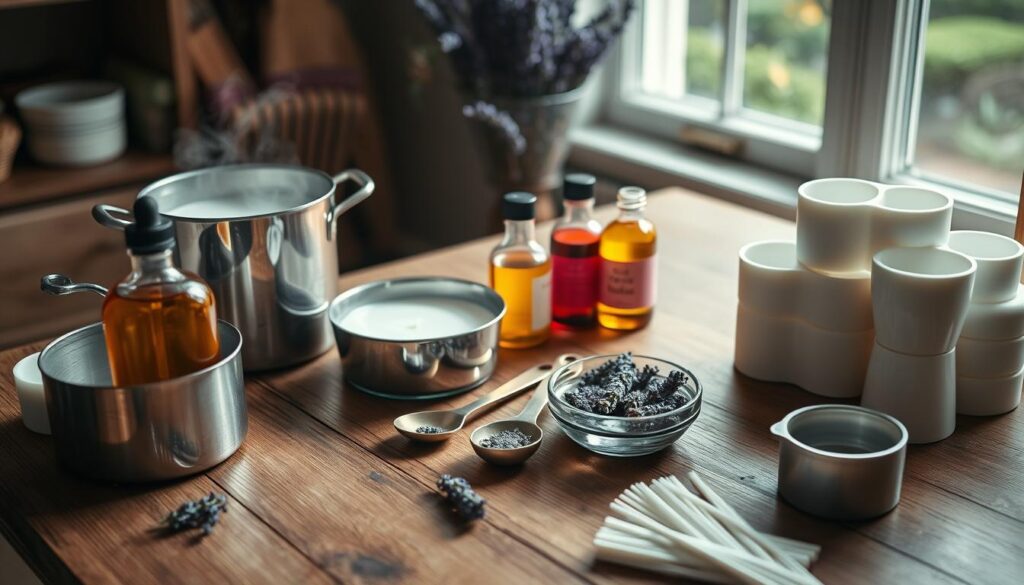
Follow these tips to master adding fragrance to soy candles. Getting the scent right takes time and practice. But by avoiding these mistakes, you’ll be well on your way to making great candles.
Step-by-Step Guide to Adding Fragrance to Your Candles
Making a scented candle is all about preparation and detail. This guide will show you how to set up your workspace and melt wax for candles.
Preparing Your Workspace
Having a clean and organized workspace is key. Here’s how to get started:
- Clear your space of clutter and arrange your tools.
- Collect wax, fragrance oils, pitchers, and wicks.
- Make sure your area is well-ventilated to avoid strong smells.
- Wear gloves and protective eyewear for safety.
Measuring and Melting Wax
Measuring and melting wax correctly is important for scent. Start by measuring your wax for the size of your containers. For example, use 6% to 8% fragrance in All Seasons Wax. This means about 27.3 ml or grams of fragrance for a 390 ml jar at 7% load.
Use a double boiler to melt wax at the right temperature. The ideal temperature is 130-140°F (50-55°C). Add fragrance oils to melted wax right away for best mixing and scent.
Let your melted mix cool a bit before pouring it into molds. Keep the pouring temperature around 140°F (60°C). This step is crucial for a smooth finish and to prevent sweating in soy content candles.
Tips for Enhancing Scent Throw in Candles
Creating candles that fill your space with delightful aromas involves understanding how to make candles smell stronger. Curing time is key in enhancing candle aromas. By following best practices for candle curing, you ensure your candles perform at their best.
Best Practices for Curing Candles
The curing process allows the wax and fragrance oil to bond effectively. This leads to a more potent fragrance when burned. Here are some key points on how to achieve optimal results:
- Allow candles to cure for at least 1-2 weeks for soy and other natural waxes to maximize scent throw.
- If using paraffin wax, aim for 3-5 days of curing time.
- Smaller candles may only require a minimum of 1 day depending on supplier recommendations.
- Maintain a consistent environment, as factors like temperature and humidity may influence fragrance release.
- Ensure proper wick size and placement, as this affects how evenly the wax melts and thus how well scents are released.
Incorporating these tips will guide you toward enhancing candle aromas effectively. Focus on the right blend of wax and fragrance, alongside optimal curing times, to create an inviting ambiance in your space.
Troubleshooting Candle Fragrance Issues
Making candles is a fun hobby, but sometimes you hit troubleshooting candle fragrance problems. Issues like weak scent throws can be a letdown. Knowing these problems helps you find weak scent throw solutions and improve your skills. Here are some key points to consider for better candle scent performance.
Weak Scent Throw Solutions
Weak scent throw is a common problem for candle makers. It’s caused by several factors:
- Low fragrance oil dosages: Make sure you’re using the right amount of fragrance oil. A good rule of thumb is 6-10% of the total wax weight.
- Wick sizing: The wrong wick size can stop your candle from melting the wax right. A too-small wick can cause tunneling, making scent dispersal hard.
- Curing time: Give your candles time to cure, usually 1-2 weeks. This lets the fragrance bind and reach its full strength.
- Slow cooling processes: When using soy wax, cool it slowly in the pour pot. This prevents frosting and bumpy tops, which can hurt scent throw.
Try different wick types and sizes. Make sure the wick is at least ¼ inch above the wax for best burning.
| Wax Type | Common Issues | Fragrance Load |
|---|---|---|
| Paraffin | Produces soot, less natural | Up to 10% |
| Soy | Frosting, bumpy tops | Up to 10% |
| Beeswax | Expensive, but burns clean | 5-8% |
| Coconut | Expensive, excellent scent throw | 6-10% |
With careful attention and some trial and error, you can solve these problems. Improving your candle scent performance makes your candles more fragrant and enjoyable.
Conclusion
DIY candle making is a fun way to show your creativity and enjoy your senses. It lets you make candles that smell great and match your style. This article has helped you learn how to make candles that smell wonderful.
Remember, use 7% to 10% fragrance in your candles for the best smell. Let your candles sit for at least 48 hours before using them. This helps them smell even better.
Creating candles is a mix of art and science. It lets you make your own special scents. Try different essential oils to find your favorite smells. Enjoy the process and make your own scented candles today!
FAQ
How do I add fragrance to my homemade candles?
To add fragrance, first measure your wax. Use 6-10% of the wax’s total weight for essential oils. For fragrance oils, use a bit more. Melt the wax to the right temperature, then mix in the fragrance well before pouring.
What are the best essential oils for candle making?
Popular essential oils for candles include lavender, eucalyptus, lemon, and peppermint. They smell great and have calming effects, making your candles more enjoyable.
How can I make my candles smell stronger?
To strengthen the scent, increase the fragrance load in your recipe. Use the right wax and let the candles cure for 24 hours after pouring. This helps the wax bind with the fragrance.
What is the difference between fragrance oils and essential oils for candles?
Essential oils are natural and come from plants, offering subtle scents. Fragrance oils are synthetic and have a wider range of scents. They provide stronger and longer-lasting smells for candles.
How do I calculate the fragrance load for my candles?
To find the fragrance load, know the wax’s total weight and multiply by the desired percentage (usually 6-10% for essential oils). For example, with 1 pound (16 ounces) of wax and a 10% load, add 1.6 ounces of fragrance oil.
What tips do you have for adding fragrance to homemade candles?
For adding fragrance, measure carefully and avoid adding scent to hot wax. Test different wick sizes and let the candles cure well to improve the scent.
Why does my candle have a weak scent throw?
A weak scent throw might be due to low fragrance oil, wrong wick size, or not curing the candle long enough. Try different variables to boost the scent.
What is the best temperature to add fragrance to candle wax?
The best temperature for adding fragrance oils is 130-140°F. This ensures the scent infuses well without evaporating.
How do I troubleshoot candle fragrance problems?
For fragrance issues, check the fragrance load, wax temperature, and wick size. Try different types and ratios to find what works best.
What are some effective candle scenting techniques?
Effective techniques include layering scents, blending oils, and trying different wax types. See how they affect the fragrance release.
Candle Making Safety Tips Every Beginner Should Know
Making candles can be a fun hobby, but safety comes first, whether you’re new or experienced. This guide will share key candle safety tips. These tips help you make beautiful candles safely. You’ll learn how to pick the right materials and care for your candles.
Picture this: you’ve made your first batch of candles, but one of them starts a small fire. It’s a sad moment to see your work go up in smoke. That’s why it’s important to know about candle making safety. With the right steps, your candles will be both beautiful and safe for everyone.
Key Takeaways
- Prioritize safety in every step of the candle-making process
- Select non-toxic waxes and high-quality wicks to ensure a safe burn
- Set up a well-ventilated workspace to prevent fire hazards
- Use proper equipment and protective gear when handling hot wax
- Properly label and store your handmade candles for optimal safety
Choose the Right Materials for Safe Candle Making
When making candles at home, picking safe, non-toxic materials is key. Go for natural waxes like coconut wax. They burn clean, last longer, and don’t produce much soot. Stay away from paraffin wax because it can give off harmful fumes.
Opt for Non-Toxic Waxes and High-Quality Wicks
Picking the right wax and wick is vital for candle safety. Natural waxes, like non-toxic candle wax, are better than paraffin wax. They don’t release harmful compounds when lit. Also, choose high-quality candle wicks made for candle making to ensure a steady and safe burn.
Avoid Paraffin Wax and Substandard Materials
Don’t use paraffin wax or other substandard materials for candles. Paraffin wax can release harmful paraffin wax concerns. This can make your candles less safe and lower their quality. Pick candle making materials safety by going for non-toxic, high-quality options. This will make candle making safer and more fun.
| Material | Characteristics | Safety Considerations |
|---|---|---|
| Coconut Wax | – Clean burn – Long-lasting fragrance – Minimal soot production |
– Non-toxic – Environmentally friendly |
| Paraffin Wax | – Inexpensive – Easy to work with |
– Can release harmful fumes – Not environmentally friendly |
“Investing in high-quality, non-toxic materials is the foundation for safe and enjoyable candle making.”
Set Up a Well-Ventilated Candle Making Area
Creating beautiful candles needs a well-ventilated space. Before starting, make sure your area is well-ventilated. This is key for well-ventilated candle making and keeping you safe, especially when indoor candle making safety matters.
To make a proper candle making workspace, follow these tips:
- Choose a spot that’s bright and has good airflow, away from drafts and busy areas.
- Make sure there’s enough air movement, like through open windows, fans, or a vent system.
- Don’t work in tight, closed spaces that can fill up with fumes quickly.
- Keep your work area clean and free from anything that could catch fire.
- Have a fire extinguisher nearby, just in case.
With a well-ventilated candle making area, you can safely enjoy making candles. A safe, comfy space is key for making great, indoor candle making safety candles you’ll be proud of.
“Proper ventilation is the key to a successful and safe candle-making experience.”
| Ventilation Recommendations | Benefits |
|---|---|
| Open windows or doors | Promotes air circulation and removes fumes |
| Use an exhaust fan | Actively pulls in fresh air and expels hot, stale air |
| Dedicated ventilation system | Ensures a consistent, controlled airflow for the workspace |
Candle Making Safety Tips for Handling Hot Wax
Handling hot wax safely is key in candle making. Keeping the wax at the right temperature is vital. It helps prevent accidents and keeps your candles safe.
Avoid Overheating the Wax
Don’t let the wax get too hot. It’s dangerous and can ruin your candles. Always check the melting point for your wax type. Keep an eye on the temperature to stay within safe limits.
Use Proper Equipment and Protective Gear
Good equipment is a must for safe wax handling. Use a thermometer to check the wax’s temperature. Choose containers and tools that can handle heat. Also, wear protective gear for candle making, like heat-resistant gloves, to avoid burns or spills.
| Equipment | Purpose |
|---|---|
| Thermometer | Accurately measure wax temperature to ensure candle wax temperature control |
| Heat-resistant containers | Safely hold and pour hot wax |
| Sturdy stirring utensils | Mix and blend wax and additives without risk of breakage |
| Heat-resistant gloves | Protect hands from burns during candle making equipment safety |
Follow these safe wax handling tips and use the right gear. This way, you’ll have a safe and fun time making candles.
Prevent Wax Spills and Burns
When making candles, keeping wax spills and fire safety in mind is crucial. It’s important to keep flammable materials away from your work area. This ensures a safe candle-making experience.
Keep Flammable Materials Away
Accidental wax spills can easily set off things like paper towels, curtains, or loose clothes. This can lead to serious fire hazards. To avoid this, keep your workspace clean and organized. Here are some safety tips:
- Make sure your work area is well-ventilated and free from flammable materials.
- Have a fire extinguisher ready for emergencies.
- Wear heat-resistant gloves when handling hot wax.
- Avoid loose clothing or jewelry that could catch fire.
By following these steps, you can safely enjoy making candles. This way, you’ll prevent wax spills and burns.
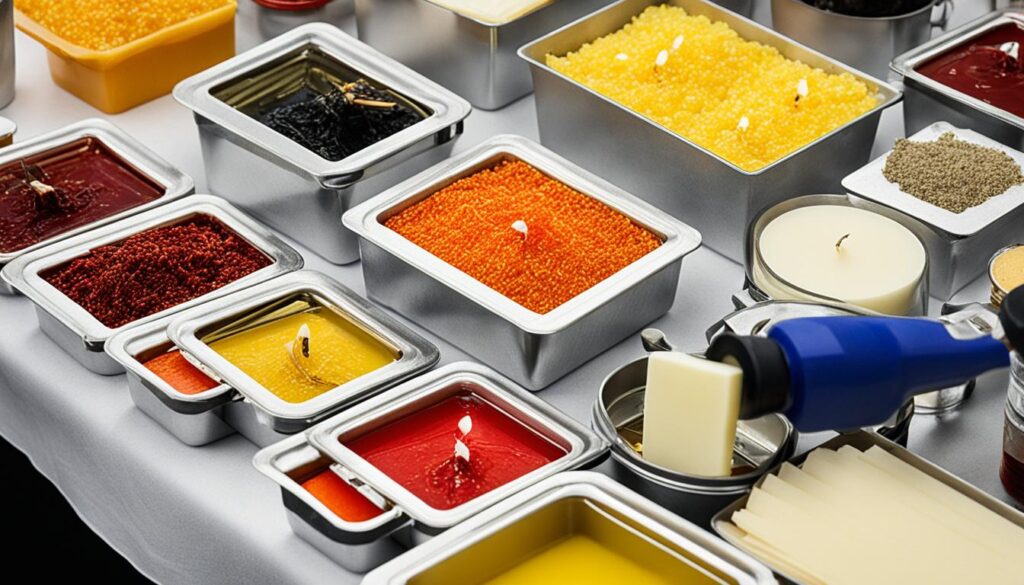
“Candle making is a creative and rewarding hobby, but it’s crucial to prioritize safety throughout the process.”
Candle Making Safety Tips for Fragrance Oils
When making scented candles, it’s key to pick fragrance oils made for candle-making. These oils work well with heat and wax, giving a steady and safe scent. Also, be sure to add the fragrance oil at the right temperature. Adding it at the wrong temperature can affect the candle’s quality and safety.
Choose Fragrance Oils Suitable for Candles
Not all fragrance oils are the same for candle making. Choose oils made for candles and tested for heat and wax safety. These oils mix well with the wax, giving a strong scent throughout the candle’s life.
Add Fragrance at the Right Temperature
Adding fragrance oil to melted wax at the right temperature is key for candle safety and quality. Always follow the maker’s instructions, as different waxes and oils need different temperatures. Wrong temperatures can cause poor scent, uneven distribution, or even fire hazards.
| Candle Fragrance Oil Safety Tips | Fragrance Oils for Candle Making | Adding Fragrance to Candles |
|---|---|---|
|
|
|
By following these safety tips, you can make scented candles that are both beautiful and safe for everyone.
Test and Cure Your Candles Before Use
Before you share your handmade candles, make sure to test them. This ensures they burn well and safely. Testing helps you fix any issues before giving them to customers. Also, let your candles cure for 24-48 hours before lighting them. This step lets the fragrance fully mix into the wax, making the scent stronger when you burn them.
When testing your candles, light them and watch for at least an hour. Look for uneven burning, too much soot, or tunneling. If you see any problems, adjust the wick or wax mix for your next batch. Curing your candles is key too. It makes the wax hard and the scent strong, giving your customers a better experience.
“Proper testing and curing are the keys to creating safe, high-quality candles that your customers will love.”
By using these safety tips, you can be sure your candles are ready and will burn well for your customers.
Curing and Testing Checklist
- Conduct a burn test for at least 1 hour, monitoring for even burning, minimal sooting, and proper wick performance
- Allow candles to cure for 24-48 hours before lighting to let the fragrance fully develop
- Make any necessary adjustments to wick length or wax blend based on burn test results
- Ensure candles are properly labeled and stored before distribution
| Curing Time | Fragrance Strength | Burn Quality |
|---|---|---|
| 24-48 hours | High | Consistent, even burn |
| 1-2 weeks | Maximum | Optimal |
Candle Making Safety Tips for Proper Labeling and Storage
When making candles, it’s important to focus on safety. This includes proper labeling and storage. If you’re giving or selling your candles, make sure to include safety instructions. This keeps your customers safe and shows you care about making candles responsibly.
When labeling your candles, list the materials, burn time, and any risks. Also, tell your customers how to burn the candle safely. Give them guidelines on how long to burn it and how close to flammable things to keep.
Storing Candles Safely
Storing candles safely is key. Candles should be kept in a cool, dry place away from direct sunlight and heat sources. This keeps the wax, wicks, and fragrances in good condition, making sure your candles stay as they should.
- Don’t store candles in damp or humid places, as this can cause wax blooming and wick damage.
- Keep candles away from windows, radiators, and other heat sources to prevent melting or warping.
- Think about using airtight containers or cabinets to protect your candles from dust, pests, and other environmental factors.
By following these candle labeling safety and safe candle storage tips, you can make sure your candle-making meets the highest safety standards. Your customers will notice the effort you put into their safety, making your candles even more appealing.
Maintain Your Candles for Optimal Safety
Keeping your candles safe and enjoyable is key. A big part of this is trimming the wicks regularly. This keeps soot away and makes the burn cleaner and more efficient. Also, how you store your candles can make them last longer and lower the risk of fires.
Trim Wicks Regularly
Always trim the wick before lighting your candle to about 1/4 inch. This makes the flame burn evenly and stops mushrooming. It’s a simple step that helps your candles last longer and burn safely.
Store Candles Properly
Store your candles in a cool, dry spot away from sunlight and heat. Heat and UV rays can melt the wax, causing it to deform and increase fire risk. Keeping them stored right also keeps their scent and quality strong for longer.
By following these candle maintenance tips, your candles will last longer and be safer. Focus on wick trimming and safe candle storage. This makes your candle-burning experience better and more sustainable.
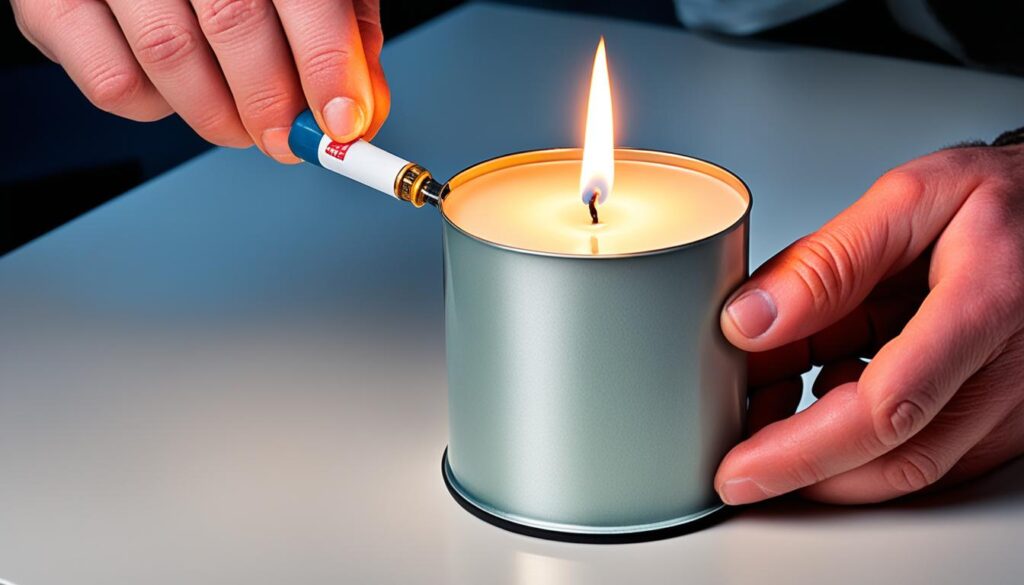
Conclusion
By following these comprehensive candle making safety tips, you can make beautiful, safe candles. These candles will have lovely scents and are made with great care. Always put safety first in candle crafting. This makes the process fun and rewarding for you and your customers.
Using the candle safety best practices from this guide will help you make safe candles with confidence. You can be creative while keeping yourself and others safe. Follow these tips to become a pro at candle making safety.
Knowledge is powerful, and it makes your candle making journey inspiring and safe. With these important safety tips, you can keep making candle crafts safely. This lets you enjoy the process without worry.
FAQ
What are the essential safety considerations when making candles?
When making candles, pick non-toxic materials like natural waxes. Use high-quality wicks and work in a well-ventilated area. Handle hot wax with care and keep flammable materials away.
How can I ensure I’m using the right materials for safe candle making?
Choose natural waxes like coconut wax. Pick high-quality, well-designed wicks made for candle making. Don’t use paraffin wax because it can release harmful fumes.
Why is a well-ventilated workspace important for candle making?
Adequate ventilation helps get rid of fumes during wax melting and pouring. This makes your workspace safer, especially when working inside.
How can I safely handle hot wax during the candle-making process?
Avoid overheating the wax and follow the melting temperature guidelines. Use quality candle-making tools like a thermometer and heat-resistant containers. Wear heat-resistant gloves to prevent burns or spills.
What precautions should I take to prevent wax spills and fires?
Keep flammable items like paper towels and loose clothing away from your work area. Keep your workspace clean and organized to lower accident risks.
How do I ensure my scented candles are safe to use?
Use fragrance oils made for candle making. Add them at the right temperature. Do burn tests before sharing your candles with others.
What steps should I take to prepare my candles for safe use?
Let your candles cure for 24-48 hours before lighting them. Include safety labels with burning instructions and hazards to know.
How can I maintain my candles for optimal safety?
Trim the wick regularly to avoid soot and keep burning clean. Store candles in a cool, dry place away from sunlight and heat to keep them safe and in good condition.
Source Links
- https://kalamazoocandle.com/blogs/learn-about-candles/candle-making-tips-tricks – 15 Candle Making Tips and Tricks (For Beginners)
- https://www.craftcoconutcandles.ca/blog/mastering-the-craft-our-guide-to-coconut-candle-making-1/candle-safety-tips-every-maker-should-know-4 – Candle Safety Tips Every Maker Should Know
- https://journalnow.com/video_0cb05630-4896-5a3e-9f28-cc573014cc5c.html – Candle making tips every beginner should know
- Fragrance That Wows: A Beginner’s Guide to Adding Scents to Your Homemade Candles
- best essential oils for candles
- wood wick guide
- how to make candles smell stronger
- how to ship candles
- how to fix soy wax frosting
- wick Guide how to choose the right wick size with chart
- how to make candle molds
- how to clean candle wax
- how to reuse candle jars
- soy wax candle troubleshooting
- best wax melter for candle making
- how to conduct burn test
- why candle flickering crackling smoking
- how much wax per candle
- how to make candles smell stronger
- Easy Ways to Increase the Scent Throw of Your DIY Candles
- How to Make Candles for Meditation and Relaxation
- Using Upcycled Materials in Candle Making
- How to Make Hand-Poured Candles: Tips and Techniques
